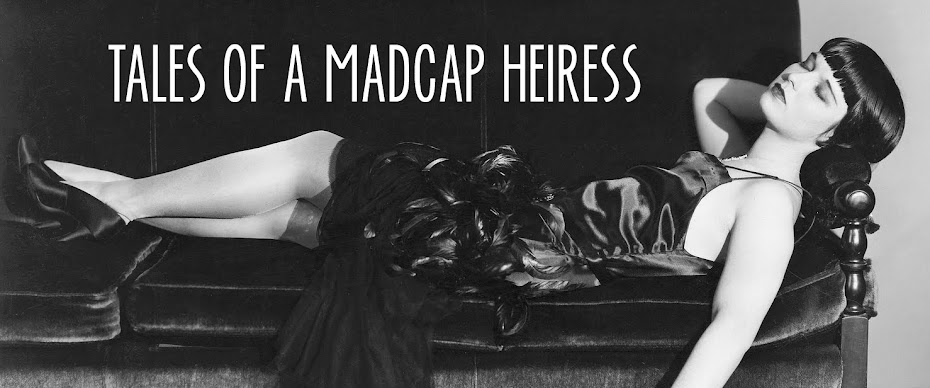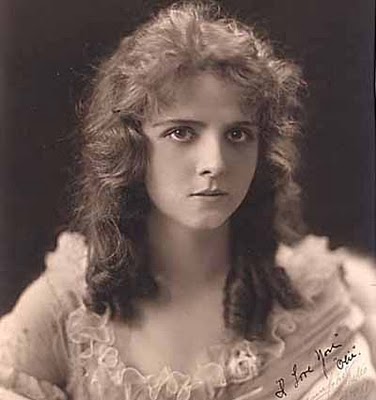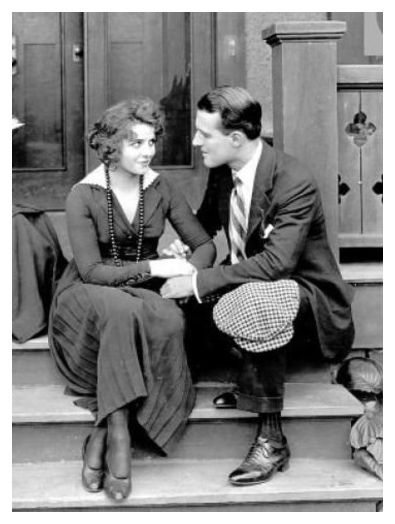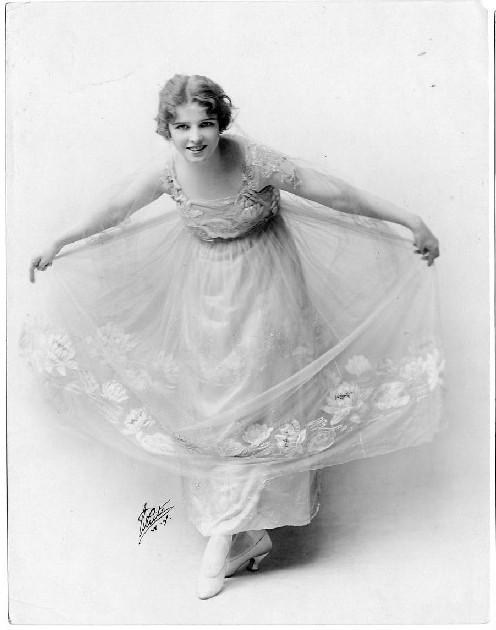Today is the birthday of one of my favourite actresses, Olive Thomas. Dubbed the most beautiful girl in the world, Olive was a rising star of the silent screen whose life was tragically cut short at the age of 25.
The photo that started my obsession with Olive Thomas.
When I was a young girl, I lived in a town where many silent films had been made, including a major Mary Pickford feature. I loved Mary and silent films in general and would pour over old Hollywood bios and picture books (alas, in those pre-video days, the chance to see silent films was rare indeed). One day my father brought home a copy of Mary Pickford’s autobiography Sunshine and Shadow. In the book was a photo of a girl with a haunting gaze—Olive Thomas. That image stayed with me for years as did the story Mary told of Olive and her tragic life. Years later, I began to dig up as much information as I could about her.
Olive in the Follies.
She was born Olivia R. Duffy on October 20, 1894 in Charleroi, Pennsylvania. Poverty and the early death of her father made life hard, and Olive married Bernard Krug Thomas at the young age of 16. A few years later she escaped her husband and fled to New York City. In 1914, while working in a Harlem department store, she entered a newspaper contest looking for the most beautiful girl in New York City and won. Olive’s violet blue eyes and luxurious golden brown locks combined with her voluptuous figure made her a favourite with artists, and she modeled for the likes of Howard Chandler Christy and Harrison Fisher. Olive caught the eye of impresario Flo Ziegfeld and was soon appearing on stage at the New Amsterdam Theatre, doing double duty in the Ziegfeld Follies and the risqué Midnight Frolics. A year later, moving pictures beckoned.
Olive’s first screen appearance is a bit awkward. An actress learning how to deal with a new medium, she often seems self-conscious. Even so, it’s clear from the start that the camera loves her. Part of Olive’s appeal is how much her vitality and love of life seem to radiate from the screen. She is aware of her beauty but never seems to take it too seriously, as if she’s winking at the audience. As her later films attest, she became more confident as an actress, more at ease, and this allowed her to show off one of her strengths—comedy.
 Olive playing it up as Ginger King in The Flapper.
Olive playing it up as Ginger King in The Flapper.
She would go on to make 22 films in four years. She played a variety of roles, from girl next door to cat burglar to girl masquerading as a boy to a baby vamp. This last role, a new type of female character, led her to make film history when she starred in Alan Crosland’s The Flapper (1920), where she earned the distinction of playing the first flapper on screen. Although bobbed hair and short skirts were to come later in the decade, Olive’s character, Ginger King, has all the makings of what we now associate with the flapper spirit. Ginger goes from innocent young girl dressed in white to wearing makeup and attempting to smoke while flirting with an older man. Looking for adventure, Ginger plays the role of the flapper to the hilt but in the end returns to being a “good girl.”
Olive’s personal life was a bit more complex than that of Ginger’s. In 1916, Olive fell in love with Jack Pickford, Mary’s baby brother. The two were crazy for each other and later eloped. The dazzling couple spent much of their marriage on separate coasts filming but when they were together there was much partying and fighting. They gave each other expensive gifts and took to drinking and wrecking cars. They were an early example of the jazz-age couple who would help define the 1920s.
In the fall of 1920, they set sail for Paris for a second honeymoon, a chance to start anew. During the day Olive was fitted for new costumes and at night the couple partied in some of the most popular nightspots in the city. But the fun turned into a nightmare on September 5 when the couple returned to their room at the Ritz at 3 am. Olive prepared what she thought was a sleeping potion but mistakenly drank a solution of bichloride of mercury instead. She was rushed to the hospital but after five days of pure agony, Olive’s star dimmed and she died on September 10.
A distraught Jack accompanied Olive’s body home and confessed later that he had contemplated suicide while on board ship. Her funeral was held on September 29 at St. Thomas Episcopal Church in New York City, where the crowds swelled and women fainted. Olive was interred at Woodlawn Cemetery in the Bronx in a mausoleum with the name Pickford carved above the door. (Jack would never join Olive. He is buried with the other Pickfords in California).
Controversy has been attached to Olive’s name ever since as people debate whether her death was suicide or an accident (Paris police ruled it an accident). But to focus on her death alone takes away from the woman herself. At the time of her death, Olive was becoming a fine actress who had turned in many strong performances. On the brink of a new decade, who knows what influence she would have had on the roaring twenties. We can only speculate.
So today, on her birthday, let’s celebrate her life and remember the vivacious girl who lit up the screen with her smile and energy. Happy Birthday Olive.
To find out more about Olive Thomas, check out the documentary Olive Thomas: Everybody’s Sweetheart (the DVD comes with a restored version of The Flapper). Or visit the New Amsterdam Theatre in New York where Olive’s ghost is said to reside (that, my dear readers, is a story for another time).








what a fascinating and tragic life. WHAT a face! I must watch that documentary you've recommended.
ReplyDelete